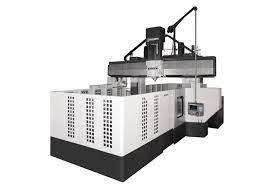
The leadership team of Okuma America Corporation is excited to announce the debut of a new double-column machining center (DCMC). This new machine – the MCR-BV - is the seventh machine offered in the company’s double-column machine line-up.
Designed as a machine for 5-face machining applications, the MCR-BV is also capable of 5-axis contouring as well as 5-sided heavy milling applications. These heavy-duty applications are made possible through features such as a powerful integral motor and spindle, an expanded work envelope, and a very rigid table which is 30% thicker than previous models, all of which is ideal for large-part machining. An abundant range of attachment heads are compatible with the machine, allowing for a wide range of unique part shapes to be created, as well as many multitasking machining functions to be performed.
Additional machine features include a fast automatic tool changer (ATC) and a smaller, faster auto attachment changer (AAC), both of which allow this DCMC to greatly increase productivity while performing heavy cutting or high-accuracy finishing.
Key Specs of the MCR-BV Double-Column Machining Center:
- Table Size mm (in): 2,000 x 4,000 (78.74 x 157.48) to 3,000 x 12,000 (118.11 x 472.44)
- Spindle Speed min⁻¹: 6,000 [10,000 option also available]
- Spindle Motor Power kW (hp): 43 (57)
- Rapid Traverse m/min (fpm): X: 30 (98.43), Y: 32 (104.99), Z: 15 (49.22)
- Magazine Capacity: 50, 80, 100, 120 or 180 Tools
Contact Details
Related Glossary Terms
- gang cutting ( milling)
gang cutting ( milling)
Machining with several cutters mounted on a single arbor, generally for simultaneous cutting.
- machining center
machining center
CNC machine tool capable of drilling, reaming, tapping, milling and boring. Normally comes with an automatic toolchanger. See automatic toolchanger.
- milling
milling
Machining operation in which metal or other material is removed by applying power to a rotating cutter. In vertical milling, the cutting tool is mounted vertically on the spindle. In horizontal milling, the cutting tool is mounted horizontally, either directly on the spindle or on an arbor. Horizontal milling is further broken down into conventional milling, where the cutter rotates opposite the direction of feed, or “up” into the workpiece; and climb milling, where the cutter rotates in the direction of feed, or “down” into the workpiece. Milling operations include plane or surface milling, endmilling, facemilling, angle milling, form milling and profiling.
- rapid traverse
rapid traverse
Movement on a CNC mill or lathe that is from point to point at full speed but, usually, without linear interpolation.
- work envelope
work envelope
Cube, sphere, cylinder or other physical space within which the cutting tool is capable of reaching.

